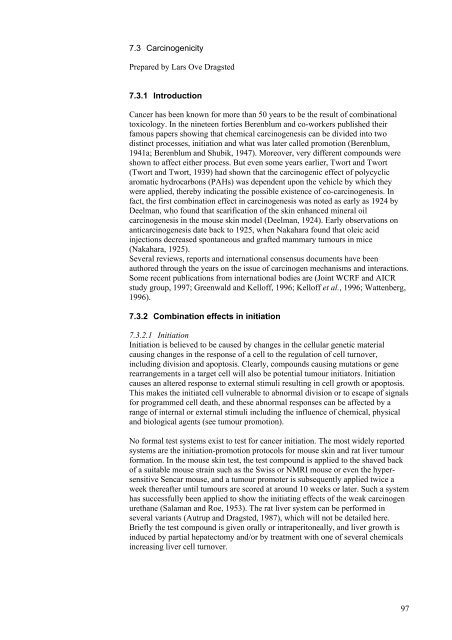Combined Actions and Interactions of Chemicals in Mixtures
Combined Actions and Interactions of Chemicals in Mixtures
Combined Actions and Interactions of Chemicals in Mixtures
Create successful ePaper yourself
Turn your PDF publications into a flip-book with our unique Google optimized e-Paper software.
7.3 Carc<strong>in</strong>ogenicity<br />
Prepared by Lars Ove Dragsted<br />
7.3.1 Introduction<br />
Cancer has been known for more than 50 years to be the result <strong>of</strong> comb<strong>in</strong>ational<br />
toxicology. In the n<strong>in</strong>eteen forties Berenblum <strong>and</strong> co-workers published their<br />
famous papers show<strong>in</strong>g that chemical carc<strong>in</strong>ogenesis can be divided <strong>in</strong>to two<br />
dist<strong>in</strong>ct processes, <strong>in</strong>itiation <strong>and</strong> what was later called promotion (Berenblum,<br />
1941a; Berenblum <strong>and</strong> Shubik, 1947). Moreover, very different compounds were<br />
shown to affect either process. But even some years earlier, Twort <strong>and</strong> Twort<br />
(Twort <strong>and</strong> Twort, 1939) had shown that the carc<strong>in</strong>ogenic effect <strong>of</strong> polycyclic<br />
aromatic hydrocarbons (PAHs) was dependent upon the vehicle by which they<br />
were applied, thereby <strong>in</strong>dicat<strong>in</strong>g the possible existence <strong>of</strong> co-carc<strong>in</strong>ogenesis. In<br />
fact, the first comb<strong>in</strong>ation effect <strong>in</strong> carc<strong>in</strong>ogenesis was noted as early as 1924 by<br />
Deelman, who found that scarification <strong>of</strong> the sk<strong>in</strong> enhanced m<strong>in</strong>eral oil<br />
carc<strong>in</strong>ogenesis <strong>in</strong> the mouse sk<strong>in</strong> model (Deelman, 1924). Early observations on<br />
anticarc<strong>in</strong>ogenesis date back to 1925, when Nakahara found that oleic acid<br />
<strong>in</strong>jections decreased spontaneous <strong>and</strong> grafted mammary tumours <strong>in</strong> mice<br />
(Nakahara, 1925).<br />
Several reviews, reports <strong>and</strong> <strong>in</strong>ternational consensus documents have been<br />
authored through the years on the issue <strong>of</strong> carc<strong>in</strong>ogen mechanisms <strong>and</strong> <strong>in</strong>teractions.<br />
Some recent publications from <strong>in</strong>ternational bodies are (Jo<strong>in</strong>t WCRF <strong>and</strong> AICR<br />
study group, 1997; Greenwald <strong>and</strong> Kell<strong>of</strong>f, 1996; Kell<strong>of</strong>f et al., 1996; Wattenberg,<br />
1996).<br />
7.3.2 Comb<strong>in</strong>ation effects <strong>in</strong> <strong>in</strong>itiation<br />
7.3.2.1 Initiation<br />
Initiation is believed to be caused by changes <strong>in</strong> the cellular genetic material<br />
caus<strong>in</strong>g changes <strong>in</strong> the response <strong>of</strong> a cell to the regulation <strong>of</strong> cell turnover,<br />
<strong>in</strong>clud<strong>in</strong>g division <strong>and</strong> apoptosis. Clearly, compounds caus<strong>in</strong>g mutations or gene<br />
rearrangements <strong>in</strong> a target cell will also be potential tumour <strong>in</strong>itiators. Initiation<br />
causes an altered response to external stimuli result<strong>in</strong>g <strong>in</strong> cell growth or apoptosis.<br />
This makes the <strong>in</strong>itiated cell vulnerable to abnormal division or to escape <strong>of</strong> signals<br />
for programmed cell death, <strong>and</strong> these abnormal responses can be affected by a<br />
range <strong>of</strong> <strong>in</strong>ternal or external stimuli <strong>in</strong>clud<strong>in</strong>g the <strong>in</strong>fluence <strong>of</strong> chemical, physical<br />
<strong>and</strong> biological agents (see tumour promotion).<br />
No formal test systems exist to test for cancer <strong>in</strong>itiation. The most widely reported<br />
systems are the <strong>in</strong>itiation-promotion protocols for mouse sk<strong>in</strong> <strong>and</strong> rat liver tumour<br />
formation. In the mouse sk<strong>in</strong> test, the test compound is applied to the shaved back<br />
<strong>of</strong> a suitable mouse stra<strong>in</strong> such as the Swiss or NMRI mouse or even the hypersensitive<br />
Sencar mouse, <strong>and</strong> a tumour promoter is subsequently applied twice a<br />
week thereafter until tumours are scored at around 10 weeks or later. Such a system<br />
has successfully been applied to show the <strong>in</strong>itiat<strong>in</strong>g effects <strong>of</strong> the weak carc<strong>in</strong>ogen<br />
urethane (Salaman <strong>and</strong> Roe, 1953). The rat liver system can be performed <strong>in</strong><br />
several variants (Autrup <strong>and</strong> Dragsted, 1987), which will not be detailed here.<br />
Briefly the test compound is given orally or <strong>in</strong>traperitoneally, <strong>and</strong> liver growth is<br />
<strong>in</strong>duced by partial hepatectomy <strong>and</strong>/or by treatment with one <strong>of</strong> several chemicals<br />
<strong>in</strong>creas<strong>in</strong>g liver cell turnover.<br />
97

















